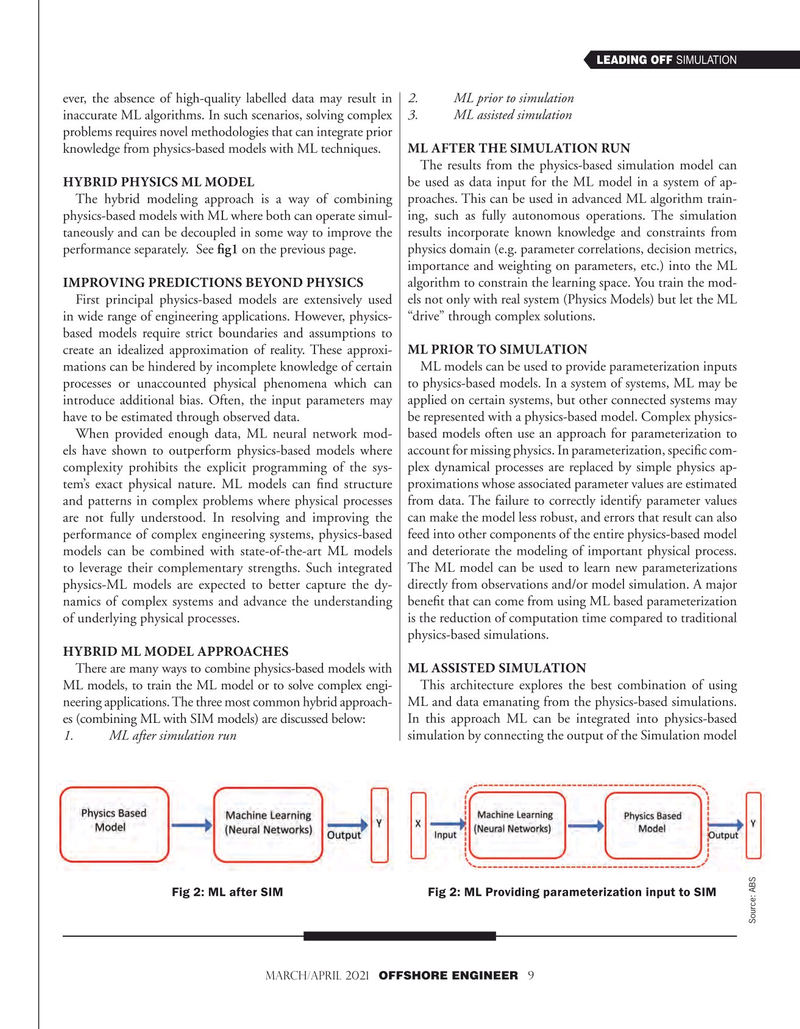
Page 9: of Offshore Engineer Magazine (Mar/Apr 2021)
Offshore Wind Outlook
Read this page in Pdf, Flash or Html5 edition of Mar/Apr 2021 Offshore Engineer Magazine
LEADING OFF SIMULATION ever, the absence of high-quality labelled data may result in 2. ML prior to simulation inaccurate ML algorithms. In such scenarios, solving complex 3. ML assisted simulation problems requires novel methodologies that can integrate prior knowledge from physics-based models with ML techniques. ML AFTER THE SIMULATION RUN
The results from the physics-based simulation model can
HYBRID PHYSICS ML MODEL be used as data input for the ML model in a system of ap-
The hybrid modeling approach is a way of combining proaches. This can be used in advanced ML algorithm train- physics-based models with ML where both can operate simul- ing, such as fully autonomous operations. The simulation taneously and can be decoupled in some way to improve the results incorporate known knowledge and constraints from performance separately. See fg1 on the previous page. physics domain (e.g. parameter correlations, decision metrics, importance and weighting on parameters, etc.) into the ML
IMPROVING PREDICTIONS BEYOND PHYSICS algorithm to constrain the learning space. You train the mod-
First principal physics-based models are extensively used els not only with real system (Physics Models) but let the ML in wide range of engineering applications. However, physics- “drive” through complex solutions. based models require strict boundaries and assumptions to create an idealized approximation of reality. These approxi- ML PRIOR TO SIMULATION mations can be hindered by incomplete knowledge of certain ML models can be used to provide parameterization inputs processes or unaccounted physical phenomena which can to physics-based models. In a system of systems, ML may be introduce additional bias. Often, the input parameters may applied on certain systems, but other connected systems may have to be estimated through observed data. be represented with a physics-based model. Complex physics-
When provided enough data, ML neural network mod- based models often use an approach for parameterization to els have shown to outperform physics-based models where account for missing physics. In parameterization, specifc com- complexity prohibits the explicit programming of the sys- plex dynamical processes are replaced by simple physics ap- tem’s exact physical nature. ML models can fnd structure proximations whose associated parameter values are estimated and patterns in complex problems where physical processes from data. The failure to correctly identify parameter values are not fully understood. In resolving and improving the can make the model less robust, and errors that result can also performance of complex engineering systems, physics-based feed into other components of the entire physics-based model models can be combined with state-of-the-art ML models and deteriorate the modeling of important physical process. to leverage their complementary strengths. Such integrated The ML model can be used to learn new parameterizations physics-ML models are expected to better capture the dy- directly from observations and/or model simulation. A major namics of complex systems and advance the understanding beneft that can come from using ML based parameterization of underlying physical processes. is the reduction of computation time compared to traditional physics-based simulations.
HYBRID ML MODEL APPROACHES
There are many ways to combine physics-based models with ML ASSISTED SIMULATION
ML models, to train the ML model or to solve complex engi- This architecture explores the best combination of using neering applications. The three most common hybrid approach- ML and data emanating from the physics-based simulations. es (combining ML with SIM models) are discussed below: In this approach ML can be integrated into physics-based 1. ML after simulation run simulation by connecting the output of the Simulation model
Fig 2: ML after SIM Fig 2: ML Providing parameterization input to SIM
Source: ABS
MARCH/APRIL 2021 OFFSHORE ENGINEER 9

 8
8

 10
10